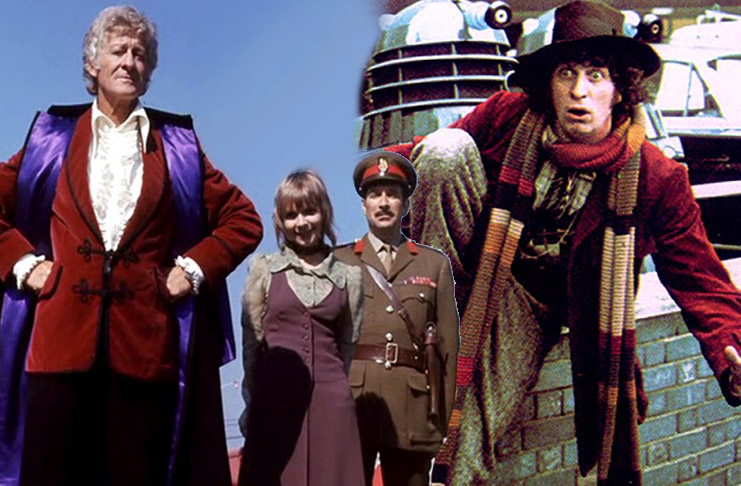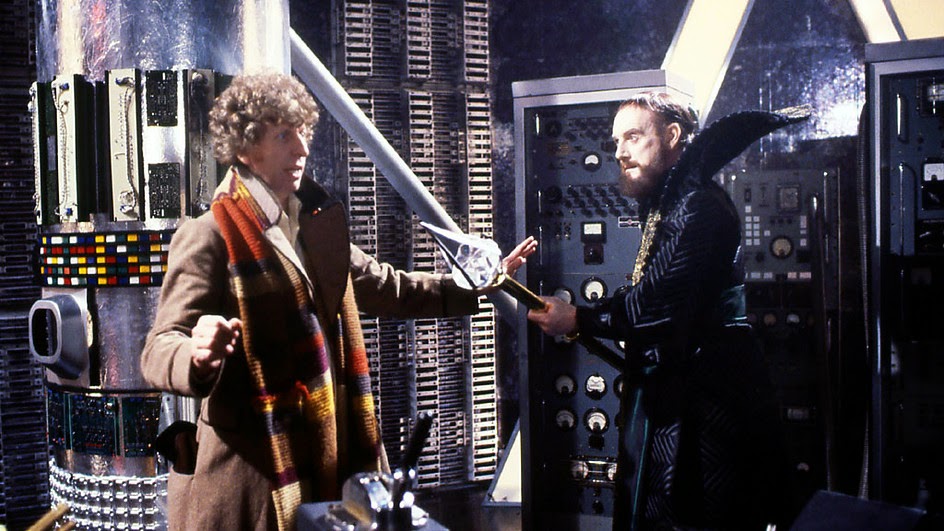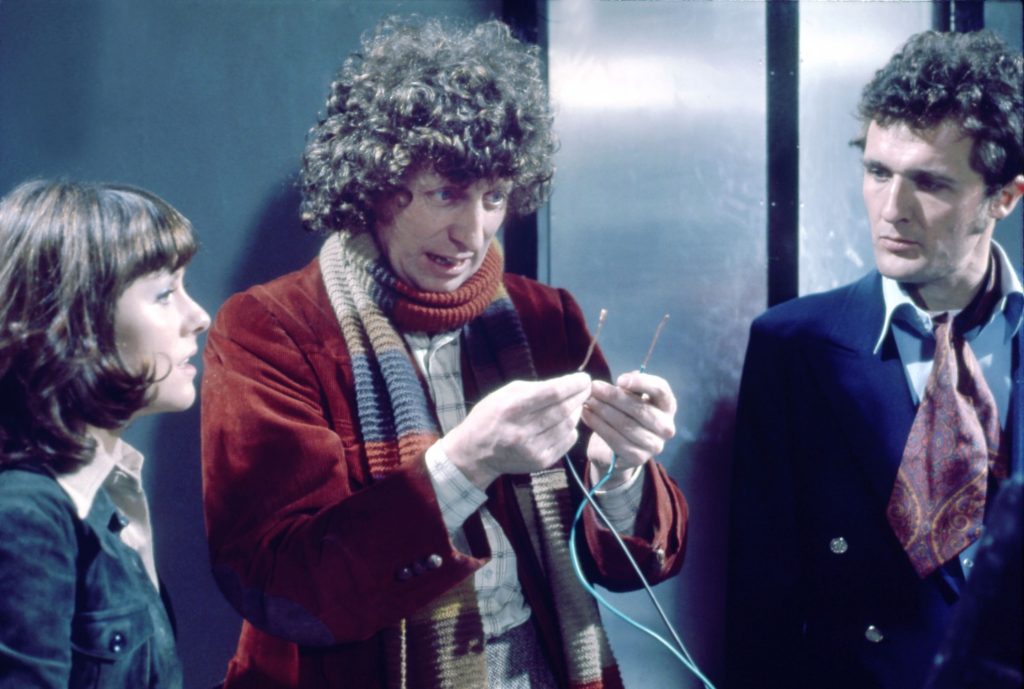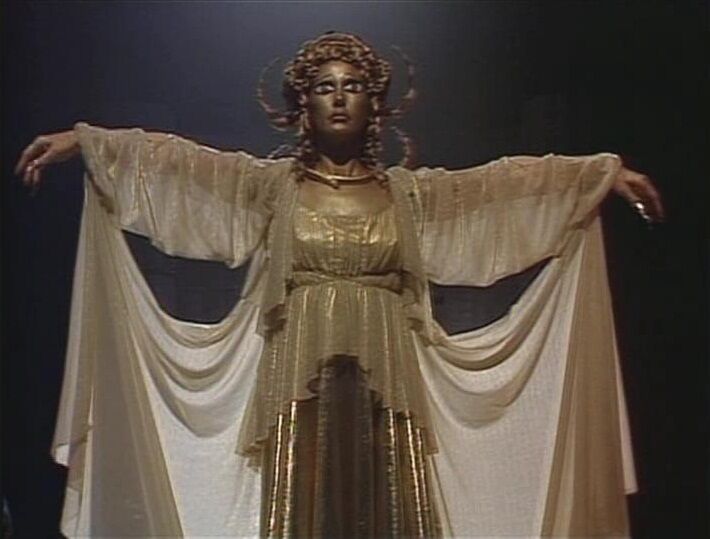 As Doctor Who June continues, I continue our look back over the history of the series and single out some of my favorite stories.
As Doctor Who June continues, I continue our look back over the history of the series and single out some of my favorite stories.
The Seventies proved to be quite a prolific time for the show. It seemed the series was reinventing itself into a sci-fi action spy show with the Third Doctor (Jon Pertwee) and UNIT before returning to all of space and time with the cosmic Bohemian Fourth Doctor (Tom Baker). The show found new heights of popularity during this time, introducing several very popular characters and concepts that continue to influence the show to this day.
This era is an embarrassment of riches, story-wise. With producers like Barry Letts, Philip Hinchcliffe, and Graham Williams, and writers like Terrance Dicks, Robert Holmes, and Douglas Adams, every season has at least one story that could be considered the best in the show’s long history. It was very difficult to pin down a list of just 10 stories. If I were to come up with numeric scores, we are talking hundredths of a point difference, in some cases.
I thought long and hard about it, and I may have made some choices you wouldn’t agree with. But since it’s my list, it’s my decision. Your mileage may vary on some of my choices.
Doctor Who Season 8 (1971)

There are several stories I could have started this list from Season 8. I went back and forth as to which one to pick. To be honest, the run from “Terror of the Autons” at the start of the 8th season right through “The Sea Devils,” halfway through Season 9 is one of the strongest runs of stories in the entire history of the show. Perhaps only bested by the Season 13 -15 run from “Pyramids of Mars” through “Talons of Weng Chiang.” So in order to keep this list to ten, I am cheating and picking this entire season.
This is the season when the UNIT team took its most successful form. The Brig and Sgt. Benton were both introduced during the 2nd Doctor era, along with UNIT, as a concept. Season 7 does a wonderful job at establishing the Third Doctor, and his place in exile on Earth. But it’s here that UNIT becomes home. Captain Mike Yates (Richard Franklin) and Jo Grant (Katy Manning) join the series. The renegade Time Lord, the Master (Roger Delgado), arrives to menace the Doctor for the first time. If this season has a weak spot, it’s when it steps away from the UNIT run, and the Doctor actually leaves Earth for “Colony in Space.” Which is not a bad story, to say the least. It’s just not as good as the Earthbound UNIT stories.
The Horns of Nimon

I know. You are reading that title, and you are like ‘What?! This guy doesn’t know what he’s talking about!” But here me out.
This story gets a lot of hate, and I get that. But it’s some of those very things I love about it. Anthony Read’s script borrows liberally from the Greek myth of the Minotaur, with the bull-headed monster and the anagrammed names (Aneth-Athens, Skonnos – Knossos), but adds a nice twist. The actual execution of the story is solid. The Nimon tricks worlds into providing the very means of their own invasion. Then the Nimon swoop in like locust, consuming every usable bit of energy from that world.
The guest cast, in particular the Skonnons, get a rough time of it, especially Soldeed (Graham Crowden). But I love his over the top, scenery chewing mad scientist. If for no other reason, he actually utters the phrase “impudent hussy” without the slightest bit of irony.
Romana gives as good as she gets from the Skonnon forces. She knows she’s far their superior, mentally, and allows them to shout and rant until they tire themselves out. (Crowden had actually been offered the role of the Doctor before Tom Baker. He turned it down, not wanting to commit to a series for three or more years.) And in a story where almost everyone’s performance goes over the top, Baker’s Doctor is actually more grounded and sedate by comparison.
It’s light and it’s fun. And I love every minute of it.
Talons of Weng Chiang

“The Talons of Weng Chiang” is one of the most revered serials in the Doctor Who canon, routinely finishing near the top of the greatest Doctor Who stories ever. And while it is a story that I do enjoy (after all it is in my top ten of the 1970s), I tend to prefer the 4 episode stories to the six. There is always just one too many delaying elements, such as a capture and escape just to end up captured again by the episode’s end.
This story succeeds on producer Philip Hinchcliffe’s use of the BBC strengths: That is, period costume drama. Hinchcliffe knew space set and heavy special effects stories could not be done well on his budget and time. (Good, fast, cheap – pick two.) So he took inspiration from gothic horror and produced stories like the “Brain of Morbius (Frankenstein) and the “Pyramids of Mars” (The Mummy). “Talons of Weng Chiang” is a telling of Sherlock Holmes meets Dr. Fu Manchu.
And yes, there are elements that have not aged well. Taken as a product of the 1970s and a story set in Victorian London, it is filled with negative Asian stereotypes, which would be appropriate for the time, but you would expect the Doctor, an alien from a different time, to be above such things. But the choice to have Caucasian actor Jon Bennett play the Chinese magician Li H’Sen Chang with prosthetics and make up is unforgivable.
That said, the story still holds up well, and it also introduces the team of Jago & Litefoot (Henry Gordon Jago (Christopher Benjamin) as the prolific purveyor of pomp presentations and Dr. George Litefoot (Trevor Baxter) as the preeminent pathologist). The fact that these two never appeared on screen again is a shame. (They have returned in several Big Finish stories, eventually getting their own audio series)
Ambassadors of Death

Jon Pertwee’s first season as the Doctor brought on a lot of changes. Exiling him to Earth and unable to use his TARDIS, the Doctor joined UNIT as their Scientific Advisor. It was also the first season to broadcast in color (or colour, as they say in the UK). All four stories in the season were strong, but pound for pound, but I feel you get the most for your money from the third serial, “Ambassadors of Death.”
The Doctor never stops moving and neither does the story. You have action, intrigue, and espinoge with the fate of the whole world at stake. A strong supporting cast paired with a great script from David Whittaker (with some uncredited help from Terrance Dicks and Malcolm Hulke), clocking in at 7 episodes, the wheels do spin a bit in the middle, but with all the action, you don’t notice that you aren’t going anywhere fast. Not every Doctor Who monster holds up over test of time, but the faceless spacesuits that kill on contact would still make me run if I saw them on the street today.
The way this story handled incidental sound and music may perhaps be the best of the series to this point. The unearthly floating music accompanied the aliens making them even more threat. And it was this story that introduced the cliffhanger stinger, which has gone on to be as iconic as the main theme or the sound of the TARDIS itself.
Genesis of the Daleks

Another story that tops many lists of the show’s greatest stories is “Genesis of the Daleks.” And it rightly earns its spot. A definitive origin to the show’s oldest and most popular monsters may not have been something we needed, but it’s now hard to imagine the show with out it.
Amazingly, this story showcases everything great about Baker’s Fourth Doctor. His wit, his strength of character, and his love and loyalty to his friends are all demonstrated here. His performance is outstanding. Along with the supporting cast, Michael Wisher turns in a delightfully evil performance as the mind behind the Dalek’s creation, Davros.
Is it a perfect story? No. But like most 6 parters, it can be too padded out. However, it does such a great job of world-building that most of the concepts introduced survive. The Time War of the modern series could be seen as starting in this very story, with the Doctor and the Time Lords taking the first shot.
Pyramid of Mars

“The Pyramids of Mars” falls right smack in the middle of the very strong Season 13. That season was the first full one where Phillip Hinchcliffe was producing scripts that he commissioned and developed. Starting with “Planet of Evil” and running right through the “Talons of Weng Chiang” in Season 15, the stories took on a gothic quality, heavily influenced by the Hammer horror films of the 1960s.
The story here is not ground breaking by any stretch. The slow-moving Mummy service robots may come off a little silly at first, but it is Gabriel Woolf delightfully evil performance that makes this story so great. Realizing that Sutekh, the main villain of the story, is held paralyzed in Egypt until the final moments of the last episode, and he still manages to cast fear and doubt over the heroes the entire time. What a voice. The story gives Baker and co-star Elisabeth Sladen some great moments together and helps cement the two as the best Doctor/Companion pairing.
The Image of the Fendahl

Once again, mankind and the world find themselves threatened by an ancient evil. The Doctor and Leela arrive back on Earth in the 1970s. (The first time back to the present since leaving Sarah Jane behind a year earlier.) There, the Doctor discovers a horror from his own childhood is real and threatens to consume all life on the planet. This may just be the darkest trip into the horror genre the series ever did up, to this point (and maybe through the end of its original run)
The script from Chris Boucher is filled with equal parts horror, science fiction, action, and drama. His characters, though a bit ‘stock,’ all have strong voices, and he uses them well to further his story. Leela is particularly well written in this story, which is not surprising as Boucher created the character the year before in “The Face of Evil.” It was sadly the last story he wrote for the series, having become the script editor for Blake’s 7 the year after. Apparently the BBC didn’t want anyone working on both series at the same time.
An interesting bit of trivia, Wanda Ventham, who plays technician Thea Ransom, is the mother of Benedict Cumberbatch.
Day of the Daleks

This 9th season entry may just be my favorite Dalek story ever.
I enjoy this story for its use of time travel. Rebels fighting against the Dalek occupying force in 22nd century come back to the present to prevent a war that weakens humanity, allowing the Daleks to swoop in and conquer the world. To prevent war, an important political figure, Lord Reginald Styles, must die. But in a twist, it turns out the rebels are coming back to kill Styles to prevent the war but actually start it in a causality loop.
The Daleks are not the best part of the story, but the introduction of their enforcers, the Ogrons, add a new twist. (It is a shame they aren’t used more.) Pertwee looks like he’s having lots of fun, whether it is drinking wine or racing ATVs around the 22nd century (the third Doctor loved all sorts of racing machines, cars, hovercrafts).
In 2011, the Special Edition DVD included new effects, including newly shot footage. All the Dalek dialogue was re-recorded, performed by Nicholas Briggs, who has provided all the Dalek voices since the show’s return in 2005.
City of Death

The Doctor and Romana take a little destination vacation to Paris, 1979.
The BBC took the show on the road filming outside of the UK for the first time in and around Paris, France. The story, written by David Fisher, was extensively rewritten by script editor Douglas Adams (yes, of Hitchhikers Guide to the Galaxy fame.) The result is a stylish mix of action and humor which keeps your attention through the end of the story.
At the time, the story got the highest viewing figures ever for an episode of Doctor Who. (Thanks, in part, due to a strike at ITV, their biggest competitor.) This serial was not an instant classic. Some fans found the amount of comedy off putting. Of course, now we expect a certain amount of levity in the series, but in 1979, this was a new direction. Fans needed to learn that it’s ok for Doctor Who to be funny too.
This story also features one of the greatest cameos in the series history. No, in all of TV history. Near the end of the last episode, the Doctor, Romana, and PI Duggan race to the TARDIS which is parked in an art gallery. There, John Cleese and Eleanor Bron expound on the blue box and how its art lies in its separation from its function. Then… well, just watch.
The Robots of Death

The story is a great take on the classic base under siege, with a little murder mystery thrown in. The crew of the Sandminer is being killed, and this time the call is coming from inside the ship! One part I, Robot and one part Murder on the Orient Express, the story succeeds on every level. Script, design, acting, and direction – it gets 10s across the board from me.
“Robots of Death” is written by Chris Boucher. (who also wrote the “Image of the Fendahl” which is number 4 on this list.) The script is tight and paced within an inch of its life. There is no filler, just thriller here. The Robots were exactly as Leela described them, “creepy mechanical men” with their pleasant, friendly voices and sing-song cadences, and blank expressionless eyes. They draw you in and freak you out all at once. I can watch this story every day (and during the pandemic, there were stretches where I did rewatch often).
This may be a sentimental choice, but it’s mine. This was the very first Doctor Who serial I discovered on New Jersey public television in 1984. And it’s one I can watch over and over again. It captured the attention and imagination of an American kid who grew up on Star Trek and Star Wars and instantly replaced those high-budget franchises in this kid’s heart. That is quite a feat. I had seen nothing quite like it, and I sought out more. I had to find out more about this strange new show. In the 1980s there was no internet. The only way to learn was word of mouth. I was lucky enough to find a few others in school over the next week who had found it as well.
What do you think? Did your favorite story make the list? Make sure to come back and check out our Top Ten Doctor Who episode lists for the 1980s and the modern series.
You can see the list for the 1960s here.
Keep coming back for more Doctor Who June fun all this month.



